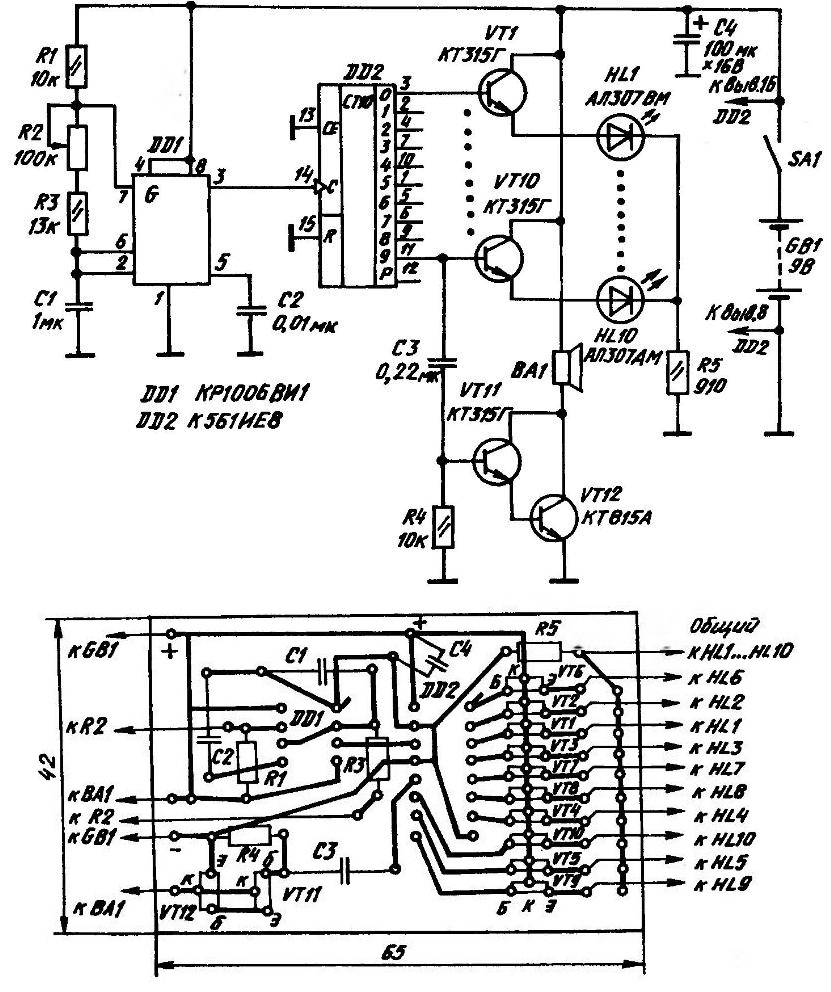
|
|
ENCYCLOPEDIA OF RADIO ELECTRONICS AND ELECTRICAL ENGINEERING Metronome conductor. Encyclopedia of radio electronics and electrical engineering
Encyclopedia of radio electronics and electrical engineering / Musician When learning to play musical instruments, a mechanical or electronic metronome is often used to set the tempo. The latter was made by me according to one of the most popular modern developments. However, in operation it turned out that such a device is inferior to its mechanical counterpart, which has an adjustable pendulum-knob, the measured swings of which are perceived as the movement of a conductor's baton. On an emergency basis, I had to make a new metronome with visual indication. I was pleased with the resulting design. And most importantly, such an electronic device soon turned out to be in demand by musician teachers for scheduled classes with their pupils, tutoring.
As you can see from the circuit diagram, my metronome includes a tempo generator, a light indication generator, and a sound signaling device. The power supply is a dry cell battery with a nominal voltage of 9 V. The tempo generator, made according to the traditional canons on the DD1 timer, generates rectangular pulses with a duty cycle close to 2. Its timing RC circuit consists of resistors R1-R3 and capacitor C1. Variable resistor R2 changes the frequency of the tempo generator in the range from 6 to 40 Hz. The received signal from pin 3 of DD1 is fed to input 14 of a decimal divider counter on the DD2 chip, the outputs of which (through current amplifiers on VT1-VT10 transistors) are loaded with HL1-HL10 LEDs. At each output of the DD1 chip, a high level appears sequentially. Moreover, only for the period of clock pulses of the tempo generator, so the LEDs light up one after another, creating the effect of a "traveling wave". At the same time, the signal through the differentiating circuit R4C3 is fed from output 11 of the DD2 microcircuit to the input of the transistor amplifier VT11-VT12, the total load of which is the dynamic head BA1. The R4C3 chain serves to shorten the rectangular pulse coming from output 11 of the DD2 microcircuit, due to which a characteristic click is heard in the loudspeaker, similar to the countdown of a mechanical metronome. In this case, the frequency of sound in the emitter can vary from 0,6 to 4 Hz by resistor R2 of the tempo generator. The elements of the device, with the exception of LEDs, a variable resistor and a power source, are placed on a printed circuit board made of one-sided foil fiberglass with dimensions of 65x42x1 mm. The topology and dimensions of the board may be different, as they depend on the shape of the parts and the device case. In the author's version, for example, a plastic case from a children's toy "balalaika" is used. We managed to place LEDs in the neck, inside the main cavity - a printed circuit board, a sound emitter and batteries, and outside - a tempo control knob and a toggle switch head. The device uses microcircuits KR1006VI1 (DD1) and K561IE8 (DD2), fixed resistors of the MLT-0,125 type and variable - SDR-Z0 class A, transistors KT315G (VT1 - VT11) and KT815A (VT12) without a radiator, capacitors K73-17 (C1 -C3) and K50-6 (C4). As a sound emitter VA1, a dynamic head 0,1 GD-12 was used. The widely known MT-1 has become the SA1 switch, but any other toggle switch can be in its place. In fact, a fairly wide replacement of parts is possible in this metronome. In particular, in place of the K561IE8 chip, K176IE8 will work well, KT1A is quite acceptable as VT11-VT3102 transistors, and KT12A is well suited for VT817. Capacitors can also be replaced with analogues in accordance with the ratings indicated on the diagram, and instead of a dynamic head, you can be content with a KM-2 telephone capsule. LEDs HL1-HL9 it is desirable to use a calm, green glow. But in place of the last (tenth), which should light up simultaneously with the click of the metronome, it is recommended to install red AL307AM. The battery of galvanic cells GB1 "Krona" serves as a power source. Assembled without errors and from serviceable parts, the metronome works immediately after being turned on. Some adjustments are made if necessary. For example, the frequency and tempo control limits are set by changing the resistance value of the resistors R1-R3 and selecting the capacitance of the capacitor C1 from the ratio f = 1,44 / (R1 + 2R2 + 2R3)C1. The desired brightness of the LEDs is regulated during the adjustment by the value of the resistance of the resistor R5. The scale of the variable resistor R2 is calibrated by comparing the sound frequency of the emitter with the vibration frequency of a mechanical metronome. Author: G.Skobelev
Artificial leather for touch emulation
15.04.2024 Petgugu Global cat litter
15.04.2024 The attractiveness of caring men
14.04.2024
▪ Chronic fatigue syndrome is chemically similar to hibernation in animals ▪ Kodak Zi8 Pocket Video Camera ▪ Artificial crystals for cooling electronics ▪ EnVerv EV8600 single-chip system
▪ section of the website Experiments in Physics. Selection of articles ▪ article The Magnificent Seven. Popular expression ▪ How was the United States of America formed? Detailed answer ▪ article Helicopter AV-1. Personal transport ▪ article Antenna at 160 m. Encyclopedia of radio electronics and electrical engineering ▪ article Rubber banknote. Focus Secret
Home page | Library | Articles | Website map | Site Reviews www.diagram.com.ua |






 Arabic
Arabic Bengali
Bengali Chinese
Chinese English
English French
French German
German Hebrew
Hebrew Hindi
Hindi Italian
Italian Japanese
Japanese Korean
Korean Malay
Malay Polish
Polish Portuguese
Portuguese Spanish
Spanish Turkish
Turkish Ukrainian
Ukrainian Vietnamese
Vietnamese

 Leave your comment on this article:
Leave your comment on this article: